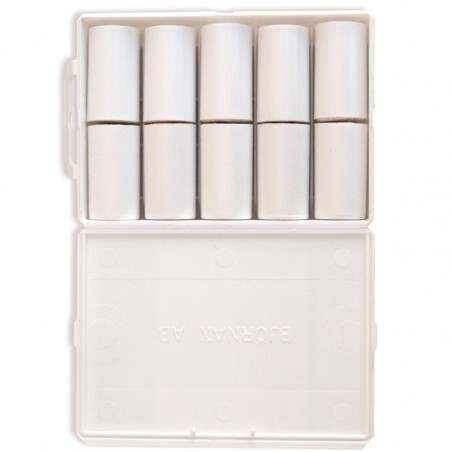Innate immune cells
Neutrophils (N) are recruited from blood at the site of inflammation/infection where they promptly phagocyte and destroy pathogens opsonized by complement. However, their action wears off quickly (24-48 hours) and then, they undergo apoptosis and are phagocytized by inflammatory macrophages.

Macrophages (M) primarily derive from blood monocytes recruited, after neutrophils, at the site of inflammation. Monocytes differentiate into activated inflammatory macrophages by means of a cascade of cytokines. Macrophages phagocytize and kill opsonized pathogens and apoptotic infected cells, produce cytokines that modulate the whole innate immune response; they are also effector cells of cell-mediated immunity and function as antigen presenting cells (APC) in secondary immune responses.
Natural Killer (NK) cells, at the site of infection, primarily recognise cells infected by an intracellular pathogen (e.g. virus) that reduces the Major Histocopatibility Complex I (MHCI) expression on their surface. NKs then eliminate infected cells by apoptosis. They are also effectors of specific cell-mediated immunity as antibody-dependent cellular cytotoxicity.
ɣ/δ T lymphocytes have ɣ/δ T Cell Receptors (TCRs) which recognize a variety of antigens with a MHC non-restricted mechanism. They are primarily engaged in innate immunity against infectious agents, including virus and bacteria, and when activated are important producers of IFNɣ and IL-17. In pigs, high percentages are found in blood, skin, intestinal epithelia, esophagus, trachea, bladder and mammary gland.
Natural Killer T (NKT) cells share characteristics of both innate and acquired immunity cells. NKT cells are capable of regulating immunity through the release of cytokines, activation of other immune components and cytolytic attack. NKT cells thereby represent the border between the innate and the acquired immune system.
Dendritic cells (DCs) are tissue resident cells and mature as professional antigen presenting cells (APCs) after TLR-mediated pathogen recognition, antigen capture and activation through innate cytokines. They internalize and process exogenous antigen, presenting antigen fragments associated with MHC II [SLA II: Swine Leucocyte Antigen II”] to antigen specific T helper Lymphocyte. APCs produce cytokines that polarize the differentiation of Thelper and thus regulate whether an antigen will trigger a humoral or a cell mediated immune response. Two subsets of DCs have been identified. Myeloid DCs that induce maturation of Th1. Plasmacytoid DCs, in the presence of high viral load, are able to induce a Th1 response.
Mast Cells (MCs) are resident in the connective tissues of the skin and peritoneum and at intestinal and pulmonary mucosal surfaces, where they serve as sentinel cells that are able to recognize danger signals via TLRs and quickly release inflammatory mediators and proinflammatory and immunemodulator cytokines and many chemokines.

Specific immune cells
T helper lymphocytes (Th) are arguably the most important cells in specific immunity, because they activate, regulate and direct the immune response. Naïve T helper cells recognize antigens presented in association to MHC II molecules by APCs; depending on the type of APC, on the initial innate immune response and on the type of cytokines present in the microenvironment, Th can differentiate into different subsets of lymphocytes (Th1, Th2, Th17, Th9, Th22 and Treg) which can promote the development of different types of immune response according to their production of a different cytokine pattern.
Th1 are responsible of cell-mediated immunity against intracellular pathogens.
Th2 control humoral immunity. Some of these Th2 cytokines downregulate Th1 cytokine production, while others facilitate humoral responses particularly IgA and IgE production.
Th17 promote innate defensive against bacteria and fungi mostly at mucosal level.
Th22 cells play an important role in epidermal immunity.
Th9 are similar functions with Th2 cells, by collaborating with them in regulating allergic inflammation and resistance against intestinal nematodes.
T regulatory lymphocytes (Treg) are involved in the shutdown of the immune response, promoting the establishment and maintenance of immune homeostasis and peripheral self-tolerance. Treg cells have an immunosuppressive activity.
Naive B lymphocytes (B) express both surface IgM and IgD classes. Once they recognize specific native antigens, they activate and differentiate into plasma cells which secrete antibodies [Antibody Secreting Cells (ASC); Immunoglobulins (Ig)]. Activated B cells then process and present specific antigens with MHC-II to helper T lymphocytes, promoting antibody isotypic switching. Isotypic switching assures that B cells will begin to express only one type of Ig, depending upon which cytokine signals received from Thelper cells.
Cytotoxic T Lymphocytes (CTL) have a MHC I, cytolytic action and kill infected cells by apoptosis. Target cells for CTL include virus-infected cells, cells infected with intracellular bacterial or protozoal parasites and cancer cells. After response against infection, most of these CTLs will die, but some will become long living memory cells.
Innate lymphocyte cells (ILC) are lymphocytes not expressing receptors for specific antigen recognition and activated by cytokines produced by other cells (LTh) in the microenvironment. ILC1, 2 and 3 have been discovered at mucosal and barrier surfaces, and regulate immune responses and tissue homeostasis with similarity to the Th1, Th2 and Th17 responses.





